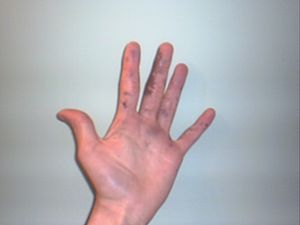Chemical burn facts for kids
A chemical burn occurs when living tissue is exposed to a corrosive substance such as a strong acid or base. Chemical burns follow standard burn classification and may cause extensive tissue damage. The main types of irritant and/or corrosive products are: acids, bases, oxidizers / reducing agents, solvents, and alkylants. Additionally, chemical burns can be caused by some types of chemical weapons, e.g., vesicants such as mustard gas and Lewisite, or urticants such as phosgene oxime.
Chemical burns may:
- need no source of heat,
- occur immediately on contact,
- not be immediately evident or noticeable,
- be extremely painful,
- diffuse into tissue and damage structures under skin without immediately apparent damage to skin surface.
Presentation
The exact symptoms of a chemical burn depend on the chemical involved. Symptoms include itching, bleaching or darkening of skin, burning sensations, trouble breathing, coughing blood and/or tissue necrosis. Common sources of chemical burns include sulfuric acid (H2SO4), hydrochloric acid (HCl), sodium hydroxide (NaOH), lime (CaO), silver nitrate (AgNO3), and hydrogen peroxide (H2O2). Effects depend on the substance; hydrogen peroxide removes a bleached layer of skin, while nitric acid causes a characteristic color change to yellow in the skin. Chemical burns may occur through direct contact on body surfaces, including skin and eyes, via inhalation, and/or by ingestion. Lipophilic substances that diffuse efficiently in human tissue, e.g., hydrofluoric acid, sulfur mustard, and dimethyl sulfate, may not react immediately, but instead produce the burns and inflammation hours after the contact. Chemical fabrication, mining, medicine, and related professional fields are examples of occupations where chemical burns may occur. Hydrofluoric acid leaches into the bloodstream and reacts with calcium and magnesium, and the resulting salts can cause cardiac arrest after eating through skin.
Other pages
See also
 In Spanish: Quemadura química para niños
In Spanish: Quemadura química para niños


